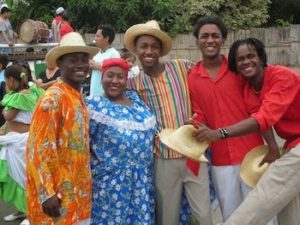
*The Afro Ecuadorian community is celebrated on this date in 1553. Also called Afroecuatorianos, they are Ecuadorians of indigenous Sub-Saharan African descent.
Most Afro Ecuadorians are the descendants of enslaved Africans transported by Spanish slavers through the middle passage. In 1553, the first enslaved Africans reached Ecuador in Quito from a slave ship heading to Peru stranded off the Ecuadorian coast. The enslaved Africans escaped and established maroon settlements in Esmeraldas, which became a haven. Many Africans fleeing slave conditions either ran there or had to live there. Eventually, they moved from their traditional homeland and settled everywhere in Ecuador.
Racism, on individual and societal levels, such as Mestizaje and Blanqueamiento (whitening), is deeply ingrained from the Spanish colonial era and is still encountered. The mestizo and criollo populations strongly discriminate against them. Poverty affects their community, with a lack of government funding and low social mobility. In 1851, after slavery, Africans became marginalized by the plantation owners. Afro Ecuadorian people and culture are found primarily in the country's northwest coastal region. 70% are found in the province of Esmeraldas and the Valle del Chota in the Imbabura Province. They are also found in Guayaquil and Ibarra.
Many of them participate in sports and hail from Valle del Chota. Afro-Auro Ecuadorian culture's historical presence is a result of slavery; its impact on Ecuador has led to the preservation of many aspects of West and Central African cultures via ordinary acts of resistance and commerce. Examples include polyrhythmic techniques, traditional instruments, dances, and foodways, such as crops from Africa, like the Plantain and Pigeon pea, and oral traditions and mythology, like La Tundra. Marimba music is popular and was considered an Intangible cultural heritage by UNESCO in 2010.
Sometimes, this music is played in religious ceremonies, as well as in celebrations and parties. It features call-and-response chanting along with the music. Some of the rhythms associated with it are currulao, bambuco and andarele. In the Chota Valley, there is bomba music. It can vary from mid-tempo to a fast tempo. It is a drum, along with a guiro, and sometimes bombos and bongos. La banda mocha plays a variation of it. Groups who play bomba with a bombo, guiro, and plant leaves to give melody. The religious practice among Afro Ecuadorians is usually Roman Catholic. Catholic worship is done with marimba.
Numerous organizations have been established in Ecuador to care for their needs. The Afro-Ecuadorian Development Council (CODE). Afro-Ecuadorian Development Corporation (Corporación de Desarrollo Afroecuatoriano, CODAE), institutionalized in 2002, Asociación de Negros Ecuatorianos (ASONE), founded in 1988, Afro-Ecuadorian Institute, founded 1989, the Agustín Delgado Foundation, the Black Community Movement (El Proceso de Comunidades Negras) and The National Confederation of Afro-Ecuadorians (Confederación Nacional Afroecuatoriana, CNA) are amongst some of the institutional frameworks in place in Ecuador.
The World Bank has funded Afro Ecuadorian development proposals in Ecuador since 1998, loaning $34 million for related projects between 2003 and 2007. USAID also overlooked the 2006 elections in Ecuador to see that Afro-Ecuadorians are represented.